-
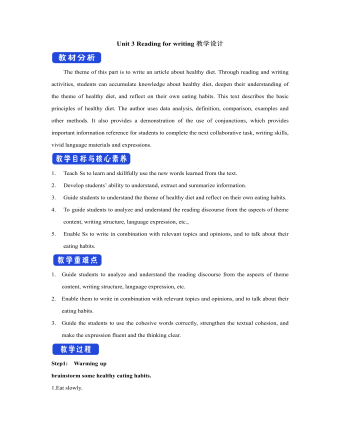
新人教版高中英语选修2Unit 3 Reading for writing教学设计
The theme of this part is to write an article about healthy diet. Through reading and writing activities, students can accumulate knowledge about healthy diet, deepen their understanding of the theme of healthy diet, and reflect on their own eating habits. This text describes the basic principles of healthy diet. The author uses data analysis, definition, comparison, examples and other methods. It also provides a demonstration of the use of conjunctions, which provides important information reference for students to complete the next collaborative task, writing skills, vivid language materials and expressions.1. Teach Ss to learn and skillfully use the new words learned from the text.2. Develop students’ ability to understand, extract and summarize information.3. Guide students to understand the theme of healthy diet and reflect on their own eating habits.4. To guide students to analyze and understand the reading discourse from the aspects of theme content, writing structure, language expression, etc., 5. Enable Ss to write in combination with relevant topics and opinions, and to talk about their eating habits.1. Guide students to analyze and understand the reading discourse from the aspects of theme content, writing structure, language expression, etc.2. Enable them to write in combination with relevant topics and opinions, and to talk about their eating habits.3. Guide the students to use the cohesive words correctly, strengthen the textual cohesion, and make the expression fluent and the thinking clear.Step1: Warming upbrainstorm some healthy eating habits.1.Eat slowly.2.Don’t eat too much fat or sugar.3.Eat healthy food.4.Have a balanced diet.Step2: Read the passage and then sum up the main idea of each paragraph.
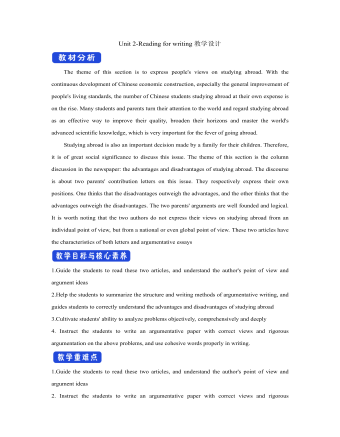
新人教版高中英语选修2Unit 2 Reading for writing教学设计
The theme of this section is to express people's views on studying abroad. With the continuous development of Chinese economic construction, especially the general improvement of people's living standards, the number of Chinese students studying abroad at their own expense is on the rise. Many students and parents turn their attention to the world and regard studying abroad as an effective way to improve their quality, broaden their horizons and master the world's advanced scientific knowledge, which is very important for the fever of going abroad. Studying abroad is also an important decision made by a family for their children. Therefore, it is of great social significance to discuss this issue. The theme of this section is the column discussion in the newspaper: the advantages and disadvantages of studying abroad. The discourse is about two parents' contribution letters on this issue. They respectively express their own positions. One thinks that the disadvantages outweigh the advantages, and the other thinks that the advantages outweigh the disadvantages. The two parents' arguments are well founded and logical. It is worth noting that the two authors do not express their views on studying abroad from an individual point of view, but from a national or even global point of view. These two articles have the characteristics of both letters and argumentative essays1.Guide the students to read these two articles, and understand the author's point of view and argument ideas2.Help the students to summarize the structure and writing methods of argumentative writing, and guides students to correctly understand the advantages and disadvantages of studying abroad3.Cultivate students' ability to analyze problems objectively, comprehensively and deeply
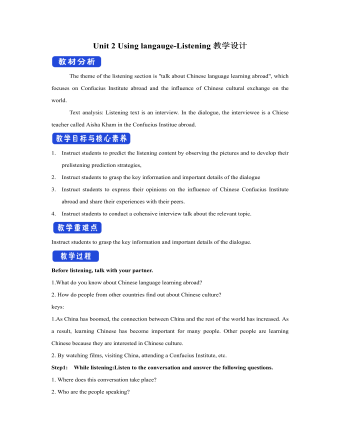
新人教版高中英语选修2Unit 2 Using langauge-Listening教学设计
? B: Absolutely! Getting involved with Chinese cultural activities there definitely helped a lot. I got to practice my Chinese on a daily basis, and I could learn how native Chinese speakers spoke.? A: What do you feel is your biggest achievement?? B: Learning Chinese characters! I have learnt about 1,500 so far. When I first started, I didn't think it was even going to be possible to learn so many, but now I find that I can read signs, menus, and even some easy newspaper articles.? A: What are you most keen on?? B: I've really become keen on learning more about the Chinese culture, in particular Chinese calligraphy. As I have learnt Chinese characters, I have developed a great appreciation for their meaning. I want to explore Chinese characters by learning how to write them in a more beautiful way. ? A: Finally, what do you want to say to anyone interested in learning Chinese?? I have really become keen on learning more about the Chinese culture, in particular Chinese Calligraphy. As I have learnt Chinese character, I have developed a great appreciation for their meaning. I want to explore Chinese characters by learning how to write them in a more beautiful way.? A: Finally, what do you want to say to anyone interested in learning Chinese?? B: I'd say, give it a shot! While some aspects may be difficult, it is quite rewarding and you will be happy that you tried.? A: Thanks for your time. ? B:You're welcome.
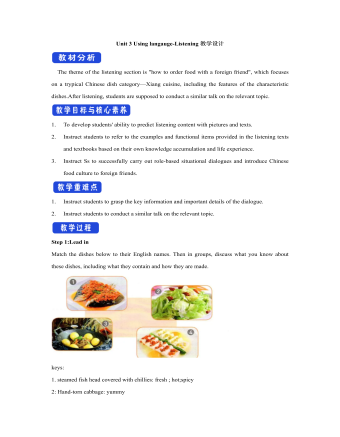
新人教版高中英语选修2Unit 3 Using langauge-Listening教学设计
1. How is Hunan cuisine somewhat different from Sichuan cuisine?The heat in Sichuan cuisine comes from chilies and Sichuan peppercorns. Human cuisine is often hotter and the heat comes from just chilies.2.What are the reasons why Hunan people like spicy food?Because they are a bold people. But many Chinese people think that hot food helps them overcome the effects of rainy or wet weather.3.Why do so many people love steamed fish head covered with chilies?People love it because the meat is quite tender and there are very few small bones.4.Why does Tingting recommend bridge tofu instead of dry pot duck with golden buns?Because bridge tofu has a lighter taste.5 .Why is red braised pork the most famous dish?Because Chairman Mao was from Hunan, and this was his favorite food.Step 5: Instruct students to make a short presentation to the class about your choice. Use the example and useful phrases below to help them.? In groups of three, discuss what types of restaurant you would like to take a foreign visitor to, and why. Then take turns role-playing taking your foreign guest to the restaurant you have chosen. One of you should act as the foreign guest, one as the Chinese host, and one as the waiter or waitress. You may start like this:? EXAMPLE? A: I really love spicy food, so what dish would you recommend?? B: I suggest Mapo tofu.? A: Really ? what's that?
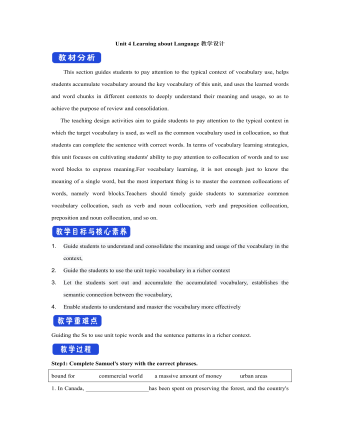
新人教版高中英语选修2Unit 4 Learning about Language教学设计
This section guides students to pay attention to the typical context of vocabulary use, helps students accumulate vocabulary around the key vocabulary of this unit, and uses the learned words and word chunks in different contexts to deeply understand their meaning and usage, so as to achieve the purpose of review and consolidation.The teaching design activities aim to guide students to pay attention to the typical context in which the target vocabulary is used, as well as the common vocabulary used in collocation, so that students can complete the sentence with correct words. In terms of vocabulary learning strategies, this unit focuses on cultivating students' ability to pay attention to collocation of words and to use word blocks to express meaning.For vocabulary learning, it is not enough just to know the meaning of a single word, but the most important thing is to master the common collocations of words, namely word blocks.Teachers should timely guide students to summarize common vocabulary collocation, such as verb and noun collocation, verb and preposition collocation, preposition and noun collocation, and so on.1. Guide students to understand and consolidate the meaning and usage of the vocabulary in the context, 2. Guide the students to use the unit topic vocabulary in a richer context3. Let the students sort out and accumulate the accumulated vocabulary, establishes the semantic connection between the vocabulary,4. Enable students to understand and master the vocabulary more effectivelyGuiding the Ss to use unit topic words and the sentence patterns in a richer context.
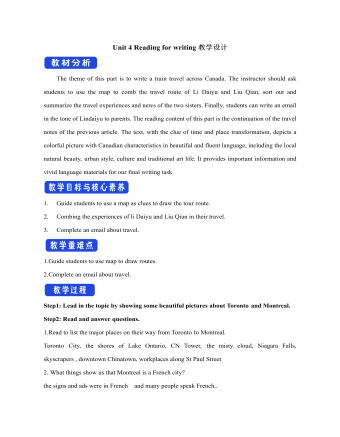
新人教版高中英语选修2Unit 4 Reading for writing教学设计
假定你是英国的Jack,打算来中国旅行,请你给你的中国笔友李华写一封信,要点如下:1.你的旅行计划:北京→泰山→杭州;2.征求建议并询问他是否愿意充当你的导游。注意:1.词数80左右(开头和结尾已给出,不计入总词数);2.可以适当增加细节,以使行文连贯。参考词汇:故宫 the Forbidden City;泰山 Mount TaiDear Li Hua,I'm glad to tell you that 'm going to visit China.First,I am planning to visit Beijing,the capitalof China,where I am looking forward to enjoying the Great Wall,the Forbidden City and somebeautiful parks.Then I intend to go to visit Mount Tai in Shandong Province.I've heard that it is one ofthe most famous mountains in China and I can't wait to enjoy the amazing sunrise there.After that,I amalso going to Hangzhou.It is said that it is a beautiful modern city with breathtaking natural sights,among which the West Lake is a well- known tourist attraction.What do you think of my travel plan? Will you act as my guide? Hope to hear from you soon.

新人教版高中英语选修2Unit 4 Using langauge-Listening教学设计
The theme of the listening section is " talking about scenery and culture along a journey."The part is designed to further lead the students to understand Canadian natural geography and social environment, and integrated into the cultural contrast by mentioning the long train journey from Beijing to Moscow routes. On this basis, the part activates students related travel experience, lets the student serial dialogue, guides the student to explore further the pleasure and meaning of the long journey, and Chinese and foreign cultural comparison.The part also provides a framework for the continuation of the dialogue, which is designed to provide a framework for students to successfully complete their oral expressions, and to incorporate an important trading strategy to end the dialogue naturally.1. Help students to understand and master some common English idioms in the context, and experience the expression effect of English idioms.2. Guide the students to understand the identity of different people in the listening context, and finish the dialogue according to their own experience.3. Instruct the students to use appropriate language to express surprise and curiosity about space and place in the dialogue, and master the oral strategy of ending the dialogue naturally.1. Instruct students to grasp the key information and important details of the dialogue.2. Instruct students to conduct a similar talk on the relevant topic.
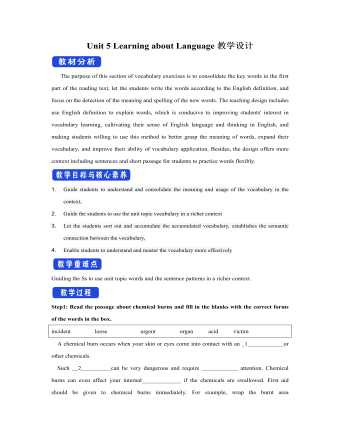
新人教版高中英语选修2Unit 5 Learning about Language教学设计
The purpose of this section of vocabulary exercises is to consolidate the key words in the first part of the reading text, let the students write the words according to the English definition, and focus on the detection of the meaning and spelling of the new words. The teaching design includes use English definition to explain words, which is conducive to improving students' interest in vocabulary learning, cultivating their sense of English language and thinking in English, and making students willing to use this method to better grasp the meaning of words, expand their vocabulary, and improve their ability of vocabulary application. Besides, the design offers more context including sentences and short passage for students to practice words flexibly.1. Guide students to understand and consolidate the meaning and usage of the vocabulary in the context, 2. Guide the students to use the unit topic vocabulary in a richer context3. Let the students sort out and accumulate the accumulated vocabulary, establishes the semantic connection between the vocabulary,4. Enable students to understand and master the vocabulary more effectivelyGuiding the Ss to use unit topic words and the sentence patterns in a richer context.Step1: Read the passage about chemical burns and fill in the blanks with the correct forms of the words in the box.
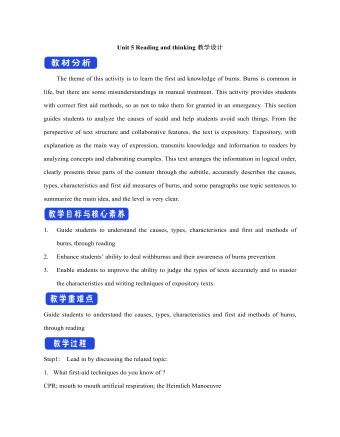
新人教版高中英语选修2Unit 5 Reading and thinking教学设计
The theme of this activity is to learn the first aid knowledge of burns. Burns is common in life, but there are some misunderstandings in manual treatment. This activity provides students with correct first aid methods, so as not to take them for granted in an emergency. This section guides students to analyze the causes of scald and help students avoid such things. From the perspective of text structure and collaborative features, the text is expository. Expository, with explanation as the main way of expression, transmits knowledge and information to readers by analyzing concepts and elaborating examples. This text arranges the information in logical order, clearly presents three parts of the content through the subtitle, accurately describes the causes, types, characteristics and first aid measures of burns, and some paragraphs use topic sentences to summarize the main idea, and the level is very clear.1. Guide students to understand the causes, types, characteristics and first aid methods of burns, through reading2. Enhance students’ ability to deal withburnss and their awareness of burns prevention3. Enable students to improve the ability to judge the types of texts accurately and to master the characteristics and writing techniques of expository texts.Guide students to understand the causes, types, characteristics and first aid methods of burns, through readingStep1: Lead in by discussing the related topic:1. What first-aid techniques do you know of ?CPR; mouth to mouth artificial respiration; the Heimlich Manoeuvre
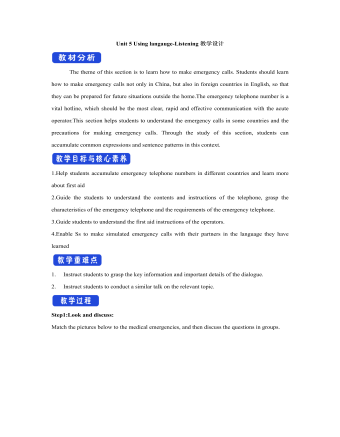
新人教版高中英语选修2Unit 5 Using langauge-Listening教学设计
The theme of this section is to learn how to make emergency calls. Students should learn how to make emergency calls not only in China, but also in foreign countries in English, so that they can be prepared for future situations outside the home.The emergency telephone number is a vital hotline, which should be the most clear, rapid and effective communication with the acute operator.This section helps students to understand the emergency calls in some countries and the precautions for making emergency calls. Through the study of this section, students can accumulate common expressions and sentence patterns in this context. 1.Help students accumulate emergency telephone numbers in different countries and learn more about first aid2.Guide the students to understand the contents and instructions of the telephone, grasp the characteristics of the emergency telephone and the requirements of the emergency telephone.3.Guide students to understand the first aid instructions of the operators.4.Enable Ss to make simulated emergency calls with their partners in the language they have learned1. Instruct students to grasp the key information and important details of the dialogue.2. Instruct students to conduct a similar talk on the relevant topic.Step1:Look and discuss:Match the pictures below to the medical emergencies, and then discuss the questions in groups.
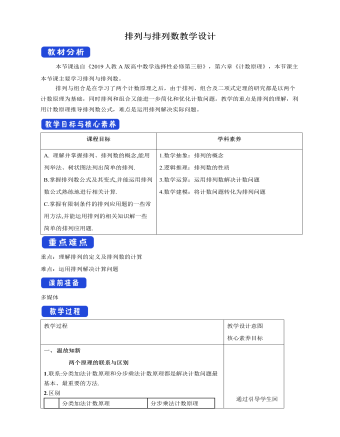
人教版高中数学选修3排列与排列数教学设计
4.有8种不同的菜种,任选4种种在不同土质的4块地里,有 种不同的种法. 解析:将4块不同土质的地看作4个不同的位置,从8种不同的菜种中任选4种种在4块不同土质的地里,则本题即为从8个不同元素中任选4个元素的排列问题,所以不同的种法共有A_8^4 =8×7×6×5=1 680(种).答案:1 6805.用1、2、3、4、5、6、7这7个数字组成没有重复数字的四位数.(1)这些四位数中偶数有多少个?能被5整除的有多少个?(2)这些四位数中大于6 500的有多少个?解:(1)偶数的个位数只能是2、4、6,有A_3^1种排法,其他位上有A_6^3种排法,由分步乘法计数原理,知共有四位偶数A_3^1·A_6^3=360(个);能被5整除的数个位必须是5,故有A_6^3=120(个).(2)最高位上是7时大于6 500,有A_6^3种,最高位上是6时,百位上只能是7或5,故有2×A_5^2种.由分类加法计数原理知,这些四位数中大于6 500的共有A_6^3+2×A_5^2=160(个).
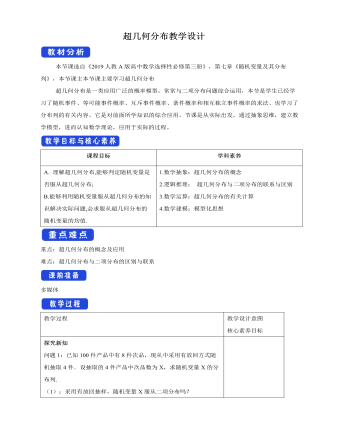
人教版高中数学选修3超几何分布教学设计
探究新知问题1:已知100件产品中有8件次品,现从中采用有放回方式随机抽取4件.设抽取的4件产品中次品数为X,求随机变量X的分布列.(1):采用有放回抽样,随机变量X服从二项分布吗?采用有放回抽样,则每次抽到次品的概率为0.08,且各次抽样的结果相互独立,此时X服从二项分布,即X~B(4,0.08).(2):如果采用不放回抽样,抽取的4件产品中次品数X服从二项分布吗?若不服从,那么X的分布列是什么?不服从,根据古典概型求X的分布列.解:从100件产品中任取4件有 C_100^4 种不同的取法,从100件产品中任取4件,次品数X可能取0,1,2,3,4.恰有k件次品的取法有C_8^k C_92^(4-k)种.一般地,假设一批产品共有N件,其中有M件次品.从N件产品中随机抽取n件(不放回),用X表示抽取的n件产品中的次品数,则X的分布列为P(X=k)=CkM Cn-kN-M CnN ,k=m,m+1,m+2,…,r.其中n,N,M∈N*,M≤N,n≤N,m=max{0,n-N+M},r=min{n,M},则称随机变量X服从超几何分布.
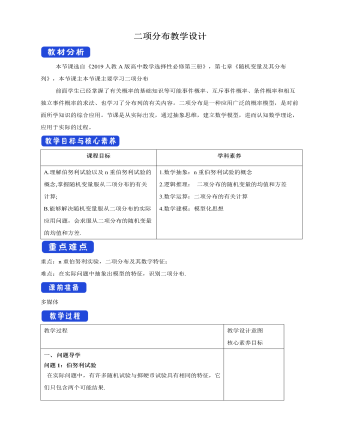
人教版高中数学选修3二项式定理教学设计
二项式定理形式上的特点(1)二项展开式有n+1项,而不是n项.(2)二项式系数都是C_n^k(k=0,1,2,…,n),它与二项展开式中某一项的系数不一定相等.(3)二项展开式中的二项式系数的和等于2n,即C_n^0+C_n^1+C_n^2+…+C_n^n=2n.(4)在排列方式上,按照字母a的降幂排列,从第一项起,次数由n次逐项减少1次直到0次,同时字母b按升幂排列,次数由0次逐项增加1次直到n次.1.判断(正确的打“√”,错误的打“×”)(1)(a+b)n展开式中共有n项. ( )(2)在公式中,交换a,b的顺序对各项没有影响. ( )(3)Cknan-kbk是(a+b)n展开式中的第k项. ( )(4)(a-b)n与(a+b)n的二项式展开式的二项式系数相同. ( )[解析] (1)× 因为(a+b)n展开式中共有n+1项.(2)× 因为二项式的第k+1项Cknan-kbk和(b+a)n的展开式的第k+1项Cknbn-kak是不同的,其中的a,b是不能随便交换的.(3)× 因为Cknan-kbk是(a+b)n展开式中的第k+1项.(4)√ 因为(a-b)n与(a+b)n的二项式展开式的二项式系数都是Crn.[答案] (1)× (2)× (3)× (4)√
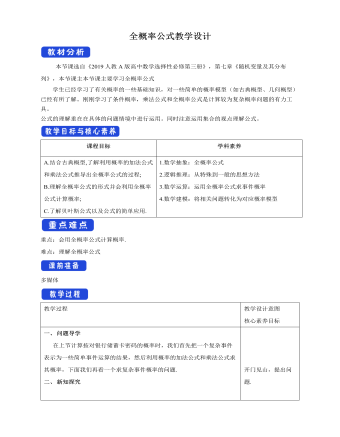
人教版高中数学选修3全概率公式教学设计
2.某小组有20名射手,其中1,2,3,4级射手分别为2,6,9,3名.又若选1,2,3,4级射手参加比赛,则在比赛中射中目标的概率分别为0.85,0.64,0.45,0.32,今随机选一人参加比赛,则该小组比赛中射中目标的概率为________. 【解析】设B表示“该小组比赛中射中目标”,Ai(i=1,2,3,4)表示“选i级射手参加比赛”,则P(B)= P(Ai)P(B|Ai)= 2/20×0.85+ 6/20 ×0.64+ 9/20×0.45+ 3/20×0.32=0.527 5.答案:0.527 53.两批相同的产品各有12件和10件,每批产品中各有1件废品,现在先从第1批产品中任取1件放入第2批中,然后从第2批中任取1件,则取到废品的概率为________. 【解析】设A表示“取到废品”,B表示“从第1批中取到废品”,有P(B)= 112,P(A|B)= 2/11 ,P(A| )= 1/11所以P(A)=P(B)P(A|B)+P( )P(A| )4.有一批同一型号的产品,已知其中由一厂生产的占 30%, 二厂生产的占 50% , 三厂生产的占 20%, 又知这三个厂的产品次品率分别为2% , 1%, 1%,问从这批产品中任取一件是次品的概率是多少?
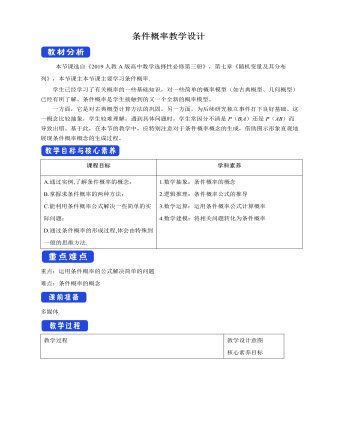
人教版高中数学选修3条件概率教学设计
(2)方法一:第一次取到一件不合格品,还剩下99件产品,其中有4件不合格品,95件合格品,于是第二次又取到不合格品的概率为4/99,由于这是一个条件概率,所以P(B|A)=4/99.方法二:根据条件概率的定义,先求出事件A,B同时发生的概率P(AB)=(C_5^2)/(C_100^2 )=1/495,所以P(B|A)=(P"(" AB")" )/(P"(" A")" )=(1/495)/(5/100)=4/99.6.在某次考试中,要从20道题中随机地抽出6道题,若考生至少答对其中的4道题即可通过;若至少答对其中5道题就获得优秀.已知某考生能答对其中10道题,并且知道他在这次考试中已经通过,求他获得优秀成绩的概率.解:设事件A为“该考生6道题全答对”,事件B为“该考生答对了其中5道题而另一道答错”,事件C为“该考生答对了其中4道题而另2道题答错”,事件D为“该考生在这次考试中通过”,事件E为“该考生在这次考试中获得优秀”,则A,B,C两两互斥,且D=A∪B∪C,E=A∪B,由古典概型的概率公式及加法公式可知P(D)=P(A∪B∪C)=P(A)+P(B)+P(C)=(C_10^6)/(C_20^6 )+(C_10^5 C_10^1)/(C_20^6 )+(C_10^4 C_10^2)/(C_20^6 )=(12" " 180)/(C_20^6 ),P(E|D)=P(A∪B|D)=P(A|D)+P(B|D)=(P"(" A")" )/(P"(" D")" )+(P"(" B")" )/(P"(" D")" )=(210/(C_20^6 ))/((12" " 180)/(C_20^6 ))+((2" " 520)/(C_20^6 ))/((12" " 180)/(C_20^6 ))=13/58,即所求概率为13/58.
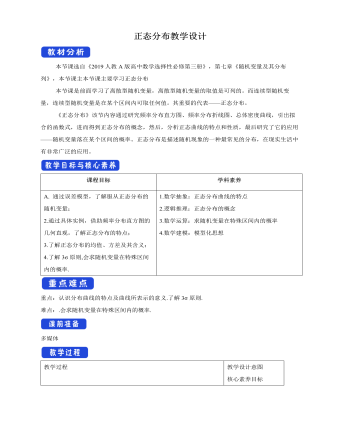
人教版高中数学选修3正态分布教学设计
3.某县农民月均收入服从N(500,202)的正态分布,则此县农民月均收入在500元到520元间人数的百分比约为 . 解析:因为月收入服从正态分布N(500,202),所以μ=500,σ=20,μ-σ=480,μ+σ=520.所以月均收入在[480,520]范围内的概率为0.683.由图像的对称性可知,此县农民月均收入在500到520元间人数的百分比约为34.15%.答案:34.15%4.某种零件的尺寸ξ(单位:cm)服从正态分布N(3,12),则不属于区间[1,5]这个尺寸范围的零件数约占总数的 . 解析:零件尺寸属于区间[μ-2σ,μ+2σ],即零件尺寸在[1,5]内取值的概率约为95.4%,故零件尺寸不属于区间[1,5]内的概率为1-95.4%=4.6%.答案:4.6%5. 设在一次数学考试中,某班学生的分数X~N(110,202),且知试卷满分150分,这个班的学生共54人,求这个班在这次数学考试中及格(即90分及90分以上)的人数和130分以上的人数.解:μ=110,σ=20,P(X≥90)=P(X-110≥-20)=P(X-μ≥-σ),∵P(X-μσ)≈2P(X-μ130)=P(X-110>20)=P(X-μ>σ),∴P(X-μσ)≈0.683+2P(X-μ>σ)=1,∴P(X-μ>σ)=0.158 5,即P(X>130)=0.158 5.∴54×0.158 5≈9(人),即130分以上的人数约为9人.
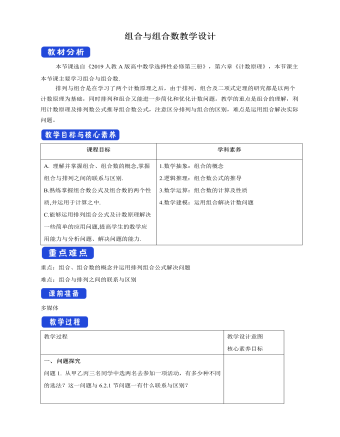
人教版高中数学选修3组合与组合数教学设计
解析:因为减法和除法运算中交换两个数的位置对计算结果有影响,所以属于组合的有2个.答案:B2.若A_n^2=3C_(n"-" 1)^2,则n的值为( )A.4 B.5 C.6 D.7 解析:因为A_n^2=3C_(n"-" 1)^2,所以n(n-1)=(3"(" n"-" 1")(" n"-" 2")" )/2,解得n=6.故选C.答案:C 3.若集合A={a1,a2,a3,a4,a5},则集合A的子集中含有4个元素的子集共有 个. 解析:满足要求的子集中含有4个元素,由集合中元素的无序性,知其子集个数为C_5^4=5.答案:54.平面内有12个点,其中有4个点共线,此外再无任何3点共线,以这些点为顶点,可得多少个不同的三角形?解:(方法一)我们把从共线的4个点中取点的多少作为分类的标准:第1类,共线的4个点中有2个点作为三角形的顶点,共有C_4^2·C_8^1=48(个)不同的三角形;第2类,共线的4个点中有1个点作为三角形的顶点,共有C_4^1·C_8^2=112(个)不同的三角形;第3类,共线的4个点中没有点作为三角形的顶点,共有C_8^3=56(个)不同的三角形.由分类加法计数原理,不同的三角形共有48+112+56=216(个).(方法二 间接法)C_12^3-C_4^3=220-4=216(个).
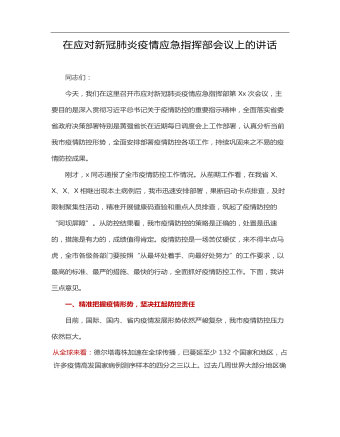
在应对新冠肺炎疫情应急指挥部会议上的讲话
此次发生的XX德尔塔变异毒株疫情,在7月20日报告首例确诊病例以来,短时间内已外溢14个省份,7月全国累计报告新增本土确诊病例328例,接近此前5个月的总和。另外7月31日,X市报告发现本土确诊病例11人,无症状感染者16人,8月1日,X又新增无症状感染者27人,初步考虑与X市第六人民医院(境外入境人员定点收治医院)关联,目前还未收到外溢报告。X洪灾时,全国各地的抗洪力量驰援X,其中不乏我省、我市前往支援的人员,这就意味着7月以来,除了X禄口机场的外溢疫情外,我们将面临第二轮可能出现的国内疫情外溢风险。部分地区确诊病例的感染源头不明,确定的高危人群还未全部核查到位,防控形势依然严峻复杂。
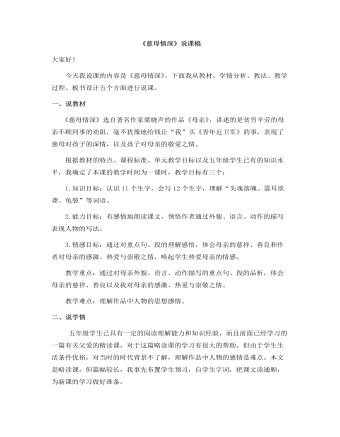
部编人教版五年级上册《慈母情深》说课稿
大家好!今天我说课的内容是《慈母情深》。下面我从教材、学情分析、教法、教学过程、板书设计五个方面进行说课。一、说教材《慈母情深》选自著名作家梁晓声的作品《母亲》,讲述的是贫穷辛劳的母亲不顾同事的劝阻,毫不犹豫地给钱让“我”买《青年近卫军》的事,表现了慈母对孩子的深情,以及孩子对母亲的敬爱之情。根据教材的特点、课程标准、单元教学目标以及五年级学生已有的知识水平,我确定了本课的教学时间为一课时,教学目标有三个:1.知识目标:认识11个生字,会写12个生字,理解“失魂落魄、震耳欲聋、龟裂”等词语。
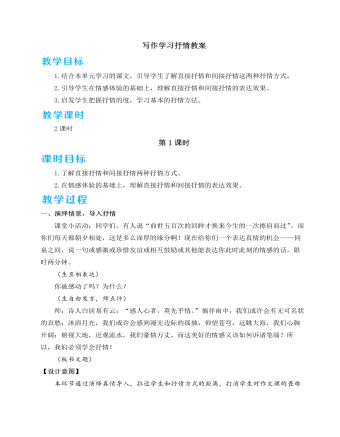
人教部编版七年级下册写作学习抒情教案
我们在湖边走着,在不高的山上走着。四周的风物秀隽异常。满盈盈的湖水一直溢拍到脚边,却又温柔地退回去了,像慈母抚拍着将睡未睡的婴儿似的,它轻轻地抚拍着石岸。水里的碎瓷片清晰可见。小小的鱼儿,还有顽健的小虾儿,都在眼前游来蹦去。登上了山巅,可望见更远的太湖。——郑振铎《石湖》(生根据师展示的原文,参考、揣摩名家笔下抒情方式的运用,体会抒情描写中以情动人的魅力)2.写一段话,抒发某种情感,如幸福、喜悦、痛苦、忧伤、渴望等。200字左右。提示:(1)可以描写场面、事物,也可以叙述故事;(2)情感的抒发要有内容,有凭借;(3)根据内容特点和表达需要,选择合适的抒情方式。(生自由习作后,小组内互评、修改)师小结:情贵在真,要注意抒发自己的真情实感。朱光潜曾说过:“作者自己如果没有感动,就绝对不能使读者感动。”在写作中,情感的抒发要自然,要水到渠成。





















